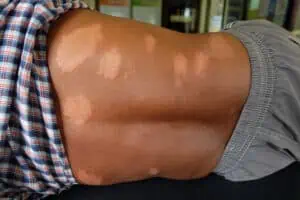
Medically reviewed by Ted Schiff, MD
You probably never thought you’d have to be on the lookout for leprosy symptoms in the 21st century. But this ancient disease never went away completely, and over the past decade, cases have doubled in the southeastern states. Leprosy in Florida—especially Central Florida—is making headlines. Given the media coverage, you may be wondering, “What does leprosy look like?” and “What causes leprosy?”
Leprosy is still very rare in the U.S., including in Florida, and 95% of people are immune to it, so there’s no cause for alarm. Still, understanding what causes leprosy and how it spreads can help put your mind at ease.
What is leprosy?
Leprosy, or Hansen’s disease, is a chronic infectious disease caused by a type of bacteria called Mycobacterium leprae. It can attack the skin, nerves, eyes and lining of the nose. The bacteria grow very slowly, and leprosy symptoms may not develop for up to 20 years after a person is exposed. The delay in the onset of symptoms can make the disease hard to diagnose.
Long before the days of antibiotics, leprosy used to inspire panic and fear. People who had it became disfigured and were shunned by society. Today, the condition is treatable.
What does leprosy look like?
Leprosy symptoms vary from person to person and look very different in the early stages vs. the late stages. Symptoms don’t appear for at least a year following infection, and most people don’t see the signs until five to seven years have passed.
The most common early leprosy symptoms are patches of skin that are either lighter than the surrounding skin or reddish. They may be numb.
Other leprosy symptoms
Nerve damage can cause weakness or paralysis of the muscles, especially in the hands and feet. If leprosy affects the lining of the nose, it can cause a stuffy nose and nosebleeds.
Additional leprosy symptoms include:
- Thick, stiff or dry skin
- Painless ulcers on the soles of the feet
- Painless swelling or lumps on the face or earlobes
- Loss of eyebrows or eyelashes
- Enlarged nerves that bulge under the skin, often on the sides of the neck and around the elbows and knees
- Eye problems
If leprosy isn’t treated, it can eventually lead to blindness or disfigurement of the hands, feet or face.
Is leprosy contagious?
Leprosy is contagious, but it’s much harder to catch than previously thought. You’d have to spend extended periods of time—thinks months, not days—in close contact with someone who has untreated leprosy to be infected. Shaking hands or talking with someone who has it won’t make you sick. And remember: If you’re among the 95% of people who are immune to the bacteria that causes leprosy, you can’t catch it.
How do you get leprosy?
People who aren’t immune to leprosy can catch it through prolonged close contact with someone who has it and isn’t being treated. They can also contract it by handling a species of armadillo found in the Southern U.S. and Mexico, some of which carry Mycobacterium leprae.
How do armadillos spread leprosy to humans? The bacteria can be passed from animal to human through touching the armadillo. Working with soil in places where infected armadillos are found can also transmit the bacteria.
Is there a cure for leprosy?
If it’s caught early, leprosy can be cured with a combination of two or three antibiotics. It typically takes six months to two years of treatment to kill the bacteria. If you have any symptoms of leprosy, chances are it’s something else entirely—but see a doctor promptly to be sure.
Leprosy pictures
These photos show what leprosy can look like in the early stages.

Credit: Shutterstock
Credit: Shutterstock
Credit: American Leprosy Missions
Written by Jessica Brown, a health and science writer/editor based in Nanuet, New York. She has written for Prevention magazine, jnj.com, BCRF.org, and many other outlets.







